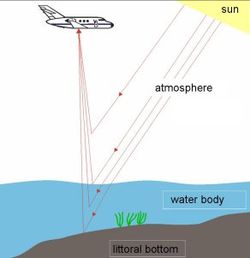Optical remote sensing
This article provides an introduction of optical remote sensing techniques. This technique can be used to detect all kind of in-water properties. This article describes the general principles of optical remote sensing, the way data can be processed and the restrictions with respect to the application of optical remote sensing.
Contents
Introduction
Remote sensing using satellite and airborne sensors is a powerful, operational tool for monitoring coastal zones. This technology can provide accurate, large-scale, synoptic environmental information essential for understanding and managing marine ecosystems. Optical multi- or hyperspectral sensor data allows the assessment of in-water properties, such as suspended matter or phytoplankton concentration, benthic substrate type, vegetation composition, and bathymetry in (optically-)shallow waters.
Principles
In the broadest sense, remote sensing is the measurement or acquisition of information of an object or phenomenon, by a recording device that is not in physical or intimate contact with the object. In practice, remote sensing is the utilization at a distance (as from aircraft, spacecraft, satellite, or ship) of any device for gathering information about the environment [1]. Passive optical sensors detect natural energy (radiation) that is emitted or reflected by the object or scene being observed. Reflected sunlight is the source of radiation measured by passive optical sensors.
In marine and aquatic environments, the sunlight spectrum is modified on its way through the atmosphere, the water surface, and the water body. In each of these boundary layers sunlight is absorbed, scattered, and reflected in a specific manner, depending on the wavelength. As a result, the reflected light carries spectral information about the particular composition of these matters.
Sensors
Each sensor has its own technical characteristics in terms of temporal, spatial, spectral, and radiometric resolution. Depending on specific requirements of a project, such as area size, availability or thematic specifications, multi- or hyperspectral detectors on space- or airborne platforms are applied.
The space agencies NASA (SeaWiFS, MODIS) and ESA (MERIS) operate the main optical remote sensing satellites currently used for aquatic and coastal remote sensing.
Data processing
Different remote sensing data processing methods are available to retrieve thematic information from remote sensing data. With mathematical and statistical methods the spectral information is analysed. Pixels are compared to specific class signatures and assigned depending on the similarity.
Physics-based retrieval algorithms
Physics-based retrieval algorithms model the complex light interactions with the atmosphere and the water body based on physical principles. Once set up, these optical models do not require manual adaptation in order to generate map products and are often independent of ground truth measurements. These algorithms are very flexible and may be applied world wide and are very under all conditions covered by the optical models upon which they are based.
Empirical algorithms
Empirical algorithms are powerful analytical tools, which rely on ground truth measurements and are typically not transferable between different aquatic and marine ecosystems.
Generic processing systems
Generic processing systems cover a wide range of applications and can be applied to new sites, applications, and sensors due to a systematic, modular approach and easy adaptations for sensor- and site-specific properties.
Geo-rectification
Geo-rectification procedures are applied to remote sensing data in order to assign each spatially-resolved pixel with a geographic coordinate. Accurate, geo-coded maps can be produced and incorporated into Geographical Information System (GIS) software. Complex trigonometric principles and procedures for geo-referencing are operational, therefore, sub-pixel accuracies can be achieved given adequate navigation data were available during collection. In practice, the spatial accuracy of operational geo-coded products depends on the accuracy of the satellite or airborne platform‘s navigation system. Therefore, for high-precision tasks, many satellite or airborne images have to be refined using manual geo-rectification approaches or automatic matching algorithms.
Restrictions
Restrictions occur whenever the object-specific signals are masked or interfered with in any ambiguous manner, with regards to both the sensor resolution and retrieval methods. Therefore only few general restrictions can be identified and most restrictions can only be determined with site-specific observations, sensors used, or algorithms applied.
General restrictions
Examples of general restrictions are clouds masking optical signals reflected from the earth surface or direct reflections from the water surface resulting in intense contributions to the recorded signal sun glitter.
Case-dependent restrictions
Examples of case-dependent restrictions are:
- Intermediate sun glitter sun glitter effects can be corrected only if the radiometric and spectral resolution of the sensor is adequate and the processing approach supports respective correction procedures (> example).
- The spatial resolution of the sensor must be higher than the spatial heterogeneity of the target areas to be mapped. Sub-pixel classification of surfaces is only possible for a very restricted number of spectral end members. At the very least, every contribution of members not implemented into the model will create inaccuracies.
- The spectral behaviour of optical classes must differ significantly from each other with respect to the sensor’s spectral resolution. E.g. Chlorophyll and dissolved organic matter (Gelbstoff) cannot be estimated independently if the sensor’s spectral and radiometric resolution is insufficient and/or the ecosystem specific absorption spectra are too similar for an independent, quantitative estimate.
See also
- Optical measurements in coastal waters
- HyMap: Hyperspectral seafloor mapping and direct bathymetry calculation in littoral zones
- Light fields and optics in coastal waters
- Optical backscatter point sensor (OBS)
- General principles of optical and acoustical instruments
- Optical Laser diffraction instruments (LISST)
- Use of Lidar for coastal habitat mapping
- data processing and output of Lidar
Notes and references
Please note that others may also have edited the contents of this article.
|
